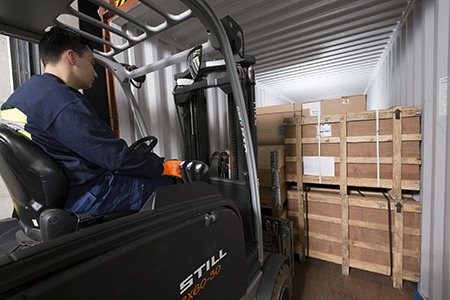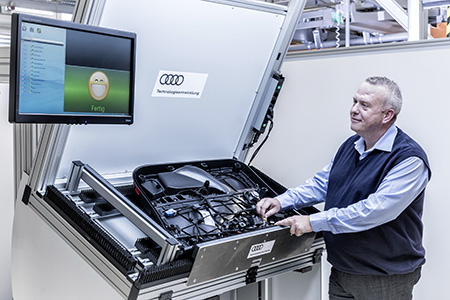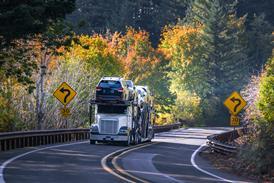 At US finished vehicle logistics specialist Jack Cooper Logistics, recounts president Andrea Amico, as part of a contract for carrying out the collection and inspection of ex-fleet vehicles on behalf of a US carmaker, the need to supply seven images of each inspected vehicle was suddenly upped to a requirement for 31 high-resolution, carefully framed photographs.
At US finished vehicle logistics specialist Jack Cooper Logistics, recounts president Andrea Amico, as part of a contract for carrying out the collection and inspection of ex-fleet vehicles on behalf of a US carmaker, the need to supply seven images of each inspected vehicle was suddenly upped to a requirement for 31 high-resolution, carefully framed photographs.
“It was slowing inspectors down,” recalls Amico, whose division manages multimodal transport, inspection, claims and title management for Jack Cooper, the largest car carrier in North America. “They had an inspection checklist to work through and a simple point-and-shoot camera, and at the end of the shift they had to copy over the photos and match them to the vehicles they had inspected.”
Nor was it simply the number of the photographs in question that was the challenge: there were strict stipulations as to how the photographs were to be framed and focused. There had to be a better way, realised Amico.
The company’s solution was to use an Android tablet containing a checklist of the photographs to be taken, with full details of the standards required, which automatically uploaded photographs and matched them to the vehicle in question. According to Amico, the app, which the company developed itself, also helped show that highly skilled and trained vehicle inspectors were not needed to take the photographs; instead, with minimal training, almost anyone could snap the photos working alongside the inspector, thus freeing up valuable inspection resources.
In a further example of Android-based ‘micro-applications’, another customer’s requirement for vehicle data capture had outgrown the capabilities of a simple yard scanner, and so was supplemented by paper-based data capture, recorded on a batch basis. Moving to an Android tablet also helped Jack Cooper to capture and update data in real time.
“Micro-applications allow us to be much more agile,” sums up Jack Cooper’s chief information officer, Kirk Hay. “Trying to do these things as an extension to our major enterprise systems would take longer and involve much more testing and training. We can experiment with a micro-application without incurring either the same cost or the same risk. People talk these days about ‘failing fast’, which isn’t how we see it. Instead, we think of it as ‘learning fast’ – there’s a big difference.”
Jack Cooper Logistics is not alone in experimenting with niche applications in the automotive supply chain. Many automotive manufacturers and 3PLs are becoming more receptive to niche, ‘bolt-on’ applications, often developed by software specialists, which can work alongside their primary systems.

Not so monolithic any moreThe Volkswagen Group has become a prime example. Over the past year, the company has begun to roll out a cloud-based software application called Discovery, which captures and shares shipping and transport operations, helping to communicate information between the carmaker’s own mainframe system and the many different systems used by its providers and suppliers. Thomas Zernechel, head of group logistics for the carmaker, recently told Automotive Logistics that the use of micro-services and apps as add-ons to its ‘backbone’ system was becoming more strategic for the group.
Many brands are moving in this direction. Audi continues to roll out a ‘mobile check-in’ application at its assembly plants; BMW uses add-on applications to its mainframe SAP system to better track inbound deliveries and trucks in real time; meanwhile, many manufacturers are using apps to process electronic proof of delivery and damage claims, as well as generating a host of productivity gains related to materials handling, picking and dispatch.
Nor is it difficult to see why such niche applications are finding favour. Once known for their monolithic closed systems and ‘not invented here’ approaches to IT, many manufacturers have already conceded that there are natural limits to their own legacy enterprise management systems, many of them highly customised and self-developed, decades old and often still in the ‘green screen era’ in terms of user experience. Carmakers have been working on improvements and updates – Ford, for instance, has made significant investments in software from German giant SAP, following this up in 2017 with investments in systems from Oracle and Infor – however, only so much can be done with the older systems in the face of persistent technological change.
“Automotive manufacturers have invested for many years in keeping their legacy systems alive with patches and extensions,” notes Paul Nurse, chief executive of ProAct International, a provider of just such niche logistics systems. “But a point is coming when this simply won’t be viable: the systems are coming to the end of their usefulness and the costs and risks of developing major software systems in-house are becoming too great to continue.”
However, there are also dangers and drawbacks to possessing an IT landscape populated by a highly fragmented collection of disparate systems and software vendors. It’s one thing to buy a system from major vendors such as SAP and Oracle and quite another for a major manufacturer to place its faith in a company that might have been a ten-person start-up a few years back. As systems proliferate, the number of interfaces and pieces of middleware to be developed and maintained will also grow. At the recent Automotive Logistics Global conference in Detroit, an executive from Volkswagen’s plant in Chattanooga, Tennessee, which only began production in 2011, noted that the plant’s manufacturing and logistics operations were characterised by over 300 separate systems and interfaces, which had begun to be seen as a barrier to rapid change.
"Automotive manufacturers have invested for many years in keeping their legacy systems alive with patches and extensions, but a point is coming when this simply won’t be viable: the systems are coming to the end of their usefulness and the costs and risks of developing major software systems in-house are becoming too great to continue." - Paul Nurse, ProAct International
Ironically, the temptation to add niche systems and micro-applications arises in the first place precisely because of the need to achieve rapid change, with externally sourced specialist software seen as a faster, cheaper way of delivering the required functionality.
“The move away from in-house systems is increasingly being driven by automotive manufacturers’ view of their own flexibility,” observes Jan Cirullies, head of logistics digitisation at Germany’s Fraunhofer Institute for Software and Systems Engineering. “They’re like supertankers, and know that they can’t turn very quickly. They know the drawbacks of systems proliferation, but if they see a business need for a software capability, they’ll accept those drawbacks if there’s no other way of meeting the need within the timescale.”
All the signs point to those needs emerging faster than ever, he adds, as intense competition butts up against a rapidly changing technology landscape, where cloud computing, mobile devices and the ‘internet of things’ (IoT) have all seen significant uptake.
“The explosion in the number of smart devices operating within logistics and manufacturing environments only increases the challenge for automotive manufacturers wanting to make use of all the data that they can provide,” Cirullies asserts. “An improved planning and prediction capability is very valuable: it becomes possible to look at activities at a highly granular level – such as individual bins and totes, for instance.”
[mpu_ad]Straight from the cloudCalifornia-based Cloudleaf, a startup founded in 2014, is a vendor aiming to capitalise on the demand for just such a capability. Holding over 40 patents, the company has built an integrated ‘mesh’ of IoT sensors, gateways and cloud applications designed to provide visibility over the location and condition of assets in the supply chain, with returnable automotive containers and stillages a prime use case.
“Once such containers arrive at the vehicle manufacturer’s assembly plant, the supplier has almost no visibility as to where they are and they can often leak out to other suppliers,” notes Cloudleaf head of marketing, Nitesh Arora. “The result is an adverse impact on both profitability and service levels.”
Among tier one and tier two suppliers, Magna and Techniplas subsidiary Dickton Masch Plastics use Cloudleaf for such capabilities, while Tesla uses Cloudleaf to track special-purpose tooling within its assembly plant, according to Arora. Customers in other industries include Shire Pharmaceuticals and ArcelorMittal, the world’s largest steel manufacturer.
It might be remarkable that a company that didn’t exist before 2014 has gained such an impressive customer base so quickly. To others, it underscores the extent to which cloud computing has simplified the business of implementing new technology: all the complexity happens in the cloud, managed by the vendor, who generally charges for it as a service. From the OEM’s point of view, the chief requirement is for a connection to the cloud server, something that software vendors go to some trouble to deliver, knowing that the lower the barriers to technology adoption, the easier it will be for customers to say ‘yes’.
 Many manufacturers want to be able to view containers at sea as a virtual warehouse but cannot do so with their existing systems
Many manufacturers want to be able to view containers at sea as a virtual warehouse but cannot do so with their existing systemsMoreover, the cloud serves not just as a processing engine, but also as a communications hub, providing a relatively straightforward way to connect businesses together, delivering unprecedented ease of visibility. Some 25,000 businesses, including Case New Holland, Caterpillar, Tesla, Renault and tier suppliers, are connected to the cloud-based trading platform GT Nexus, acquired by enterprise applications specialist Infor in 2015, and through which some $100 billion of trade is transacted each year. Those using GT Nexus’ platform also gain real-time visibility over where their goods are, thanks to a suite of niche supply chain visibility and management applications. Caterpillar, for instance, uses GT Nexus to manage $500m of in-transit inventory, notes Greg Kefer, vice-president of marketing for GT Nexus at Infor.
“Auto manufacturers invested heavily in big enterprise systems in the 1990s that were simply never designed for the extended supply chains and levels of international trade and inter-company movements that have become routine 20 years later,” he points out. “They know that they want to move to being able to view containers at sea as a virtual warehouse, and can’t see how to do it with their existing systems. They’re not always comfortable with what they see as the complexity and risk of buying in that capability, but the appeal is strong. The ROI of eliminating even one 747 freight shipment a month is unmistakable.”
Can’t see the cloud from insideIncreasingly, software providers – both major enterprise vendors and niche application providers – are not only converting ‘inside the firewall’ applications to run in the cloud but have also begun developing primarily for the cloud, seeing it as a way to replace irregular income flows from initial licence sales and periodic updates with a more attractive, regular monthly subscription income through selling their software as a service.
However, according to Matthias Berlit, vice-president of manufacturing logistics at Inform, another provider of manufacturing and logistics applications, carmakers can be a tough sell when it comes to the adoption of cloud-based applications.
“While automakers are definitely more receptive to niche applications than they were a few years back, what one hears at conferences about openness towards the cloud isn’t always replicated in one-to-one discussions about what a cloud deployment of a niche application might look like,” he notes.
“What’s more, that openness towards the cloud tends to end at the walls of the plant: for applications outside the plant, the cloud might be acceptable, but for inside the plant, they still tend not to want cloud-based applications, or indeed [want] no micro-applications at all. Instead, what they generally say that they are looking for is something that can act as a module of one of their major in-plant systems.”
 IT providers aim to supply automotive production solutions with few or no implications for in-house IT departments
IT providers aim to supply automotive production solutions with few or no implications for in-house IT departmentsThe result is often that software providers have to offer more editions of their wares: traditional licence-based software, perhaps capable of acting as a module in an in-plant system, as well as cloud-based software sold on a ‘software as a service’ basis, which is designed to be widely usable.
“The goal is to make it easy for customers to access software – for example, something that isn’t a big project for the IT department, but which simply works,” he explains. “So we have to put in a lot of effort to achieve this and make it cloud-ready. But the result is a whole new business model, with software sold as a service, rather than traditionally.”
Inform has also invested in simplifying the chore of managing and maintaining all the interfaces and middleware required to connect with niche software systems and micro-applications, by developing a single, common cloud platform for its offerings, making it straightforward for manufacturers to start with one solution and then add others as their requirements – or sense of comfort – grows. Inform has also made that platform available to other niche solution providers, holding out the prospect of manufacturers running multiple third-party niche systems through a common interface.
Just such a solution underpins the operations at one of Germany’s largest carmakers, explains Berlit. Along with Inform’s own scheduling and optimisation software, software from fellow German provider PTV Group is in use, accessed through the same interface. Specifically, while Inform has its own technology for calculating the estimated time of arrival of an inbound vehicle, the PTV system delivers a more precise calculation capability, which proved attractive to the carmaker in question.
“Both our companies are strong in optimisation, but Inform’s strengths are in optimisation in the factory and the downstream supply chain, while our expertise is in route planning and traffic simulation,” explains Frank Felten, PTV Group’s vice-president of product development.
"[OEMs’] openness towards the cloud tends to end at the walls of the plant: for applications outside the plant, the cloud might be acceptable, but for inside the plant, they still tend not to want cloud-based applications, or indeed [want] no micro-applications at all." - Matthias Berlit, Inform
“We’ll calculate an estimated time of arrival based on detailed modelling of a truck’s weight, size, applicable driver regulations over the route, traffic conditions, and so on.”
As with other areas where niche software systems are finding a foothold, not every manufacturer will find such a capability a prize worth having. But for those that do, it should be reassuring to know that it exists, and that accessing it need not burden already stretched IT functions.
As carmakers continue to update their IT landscapes and move away from inflexible legacy systems, it is likely that a growing number of manufacturers will embrace the flexibility offered by niche systems and micro-applications. It might not always feel comfortable, but the days of those in IT functions saying ‘no’ on principle appear numbered. If a decent business case can be made, then increasingly, the answer to using such apps looks more likely to be a ‘yes’.
The latest developments in IT applications for the automotive industry will be under discussion this year at the Automotive IT International conference, which is taking place on May 21st - 23rd in Atlanta, Georgia, alongside the Automotive Logistics Supply Chain conference .
Topics
- Audi
- BMW
- BMW
- Case New Holland
- Caterpillar
- Cloudleaf
- Dickton Masch Plastics
- Digitalisation
- features
- Finished vehicle logistics
- Ford
- Ford
- Fraunhofer Institute
- Inbound logistics
- Infor
- Inform
- Inplant logistics
- Inventory management
- Jack Cooper Logistics
- Magna
- OEMs
- ProAct International
- PTV Group
- Renault
- Supply chain management
- Techniplas
- Tesla
- Tier suppliers
- Volkswagen
- Volkswagen Group
- VW























